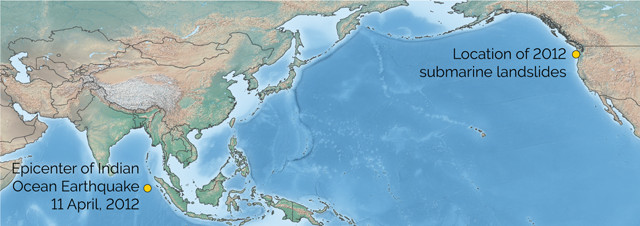
by Mary Caperton Morton Friday, October 13, 2017

Underwater landslides, called turbidity currents, occur when material on seafloor slopes destabilizes and flows downhill. In a new study, researchers suggest that shaking from a major earthquake in the Indian Ocean caused turbidity currents 13,500 kilometers away on the Cascadia Subduction Zone. Credit: K. Cantner, AGI.
Large earthquakes can nudge both nearby and distant faults closer to failure, sometimes setting off additional earthquakes halfway around the world. New evidence from the Cascadia Subduction Zone suggests that large seismic events can also trigger submarine landslides, called turbidity currents, perhaps as far as 13,500 kilometers away. If true, researchers say such long-distance connections could complicate interpretations of paleoseismic records from the Cascadia margin and elsewhere that rely on data from turbidites — the stratified remains of the underwater slides — to piece together when past local earthquakes occurred. But not everyone is convinced that long-distance landslide triggering is possible.
The Cascadia Subduction Zone, where the Juan de Fuca and two other small tectonic plates subduct under the North American Plate off the coast of Washington and Oregon, is one of the quietest subduction zones in the world. The 1,100-kilometer-long margin can generate earthquakes greater than magnitude 9, but it has been eerily quiet since the last large event in 1700. The seafloor along the margin is steep, with thick piles of sediment that stack up, sloping between 20 and 40 degrees. These conditions make the area prone to submarine landslides. “These slopes are primed to collapse in the event of an earthquake,” says Paul Johnson, an oceanographer at the University of Washington and lead author of a new study in the Journal of Geophysical Research: Solid Earth.
In 2011, researchers deployed a suite of seismic instruments on the ocean floor along the Cascadia margin to detect small tremors and other signs of activity. In June and July 2012, data from the instruments showed multiple temperature spikes at different locations along the margin. Previous studies have used such temperature spikes to track turbidity current activity, as cascading sediments pull warm water from the ocean surface toward the seafloor.
When Johnson’s team compared the timing of the temperature spikes to the global earthquake record, they concluded that the sediment flows were most likely triggered by a magnitude-8.6 earthquake that struck beneath the Indian Ocean on April 11, 2012, months before the landslides occurred and more than 13,500 kilometers from Cascadia. “Most of the 18 months we spent on this study was spent eliminating all the other possibilities,” Johnson says. “We worked with physical oceanographers and seismologists to see if there was some other trigger. We modeled upper ocean currents and storm systems and the only thing that lined up was the Indian Ocean quake. It all came down to a matter of timing.”
If such distant triggering of submarine landslides occurs, the implication is that “not all turbidites are generated by local earthquakes,” Johnson says — a finding that could call into question paleoseismic studies that rely on turbidite records to reconstruct past earthquake patterns.
But the data leave some researchers unconvinced. “I see no reason to connect these very small thermal anomalies to an earthquake that took place 13,500 kilometers away, two months prior,” says Chris Goldfinger, a marine geologist and paleoseismologist at Oregon State University who was not involved in the new study. Goldfinger says that one problem with the study is that “the only data given are the thermal anomalies, which are very small and can be due to a number of things, such as bottom-water currents.” Turbidity currents are more often studied using combined measurements of water temperature, pressure, current and transmittance, he says.
Even if the temperature changes do represent submarine landslides, linking the slides to a distant earthquake is problematic, he says. “The biggest issue with remote triggering is proving causation. These anomalies were observed two to three months after the earthquake. In my mind, that’s a fatal flaw.”
Johnson says months-long delays between earthquakes and subsequent landslides aren’t unusual for terrestrial landslides. “We know from terrestrial landslides that triggering can take a while,” he says. “It’s also very common for slides to continue for weeks as the slope restabilizes.”
But while earthquake-triggering of landslides has been observed on land, slides typically occur within 100 kilometers of the earthquake, Goldfinger says. In this case, the distance is 135 times farther. “That’s a gigantic stretch,” he says.
As for the implication that remote triggering of turbidity flows could complicate paleoseismic earthquake reconstructions, Goldfinger says he isn’t worried. “If you could trigger landslides from anywhere in the world at any time, the field of paleoseismology would be in trouble. But nothing about this study convinces me that we have a problem.”
© 2008-2021. All rights reserved. Any copying, redistribution or retransmission of any of the contents of this service without the expressed written permission of the American Geosciences Institute is expressly prohibited. Click here for all copyright requests.